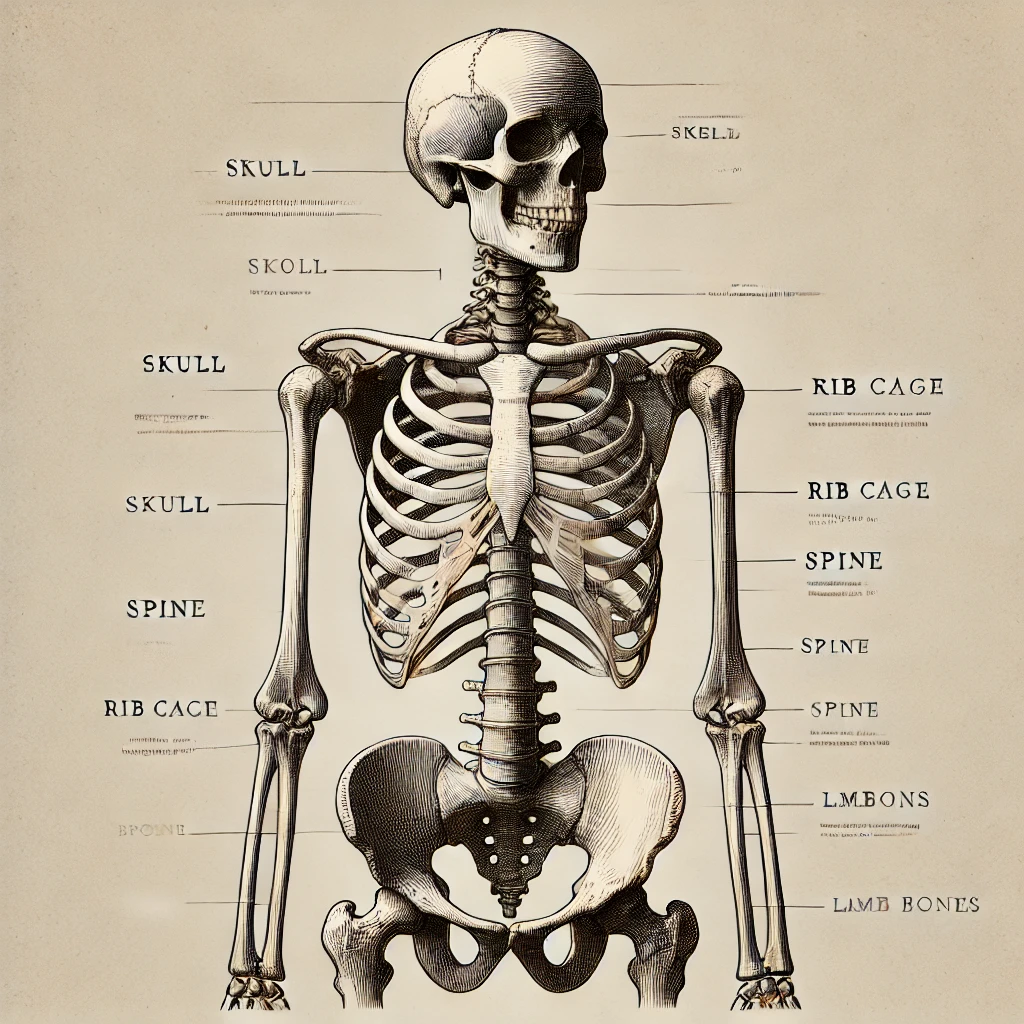Table of Contents
Drawing:9qs9xgbv4jo= Skeleton The human skeleton is one of the most fascinating aspects of our anatomy, serving as the framework for the body, providing protection to vital organs, and enabling movement. This article delves into various aspects of the human skeleton, highlighting its importance, structure, and the science behind its functions.
1. Drawing:9qs9xgbv4jo= Skeleton Understanding the Human Skeleton: An Overview

Drawing:9qs9xgbv4jo= Skeleton The human skeleton is composed of 206 bones in adults, a reduction from the 270 bones in infants due to the fusion of bones as the body matures. Each bone in the skeleton plays a critical role, from enabling movement to producing blood cells.
Composition of the Skeleton
Bones are made up of a mixture of organic and inorganic materials, primarily collagen and calcium phosphate, which contribute to both flexibility and strength. Drawing:9qs9xgbv4jo= Skeleton The human skeletal system is divided into two major sections: the axial skeleton and the appendicular skeleton. Drawing:9qs9xgbv4jo= Skeleton
The Axial Skeleton
The axial skeleton includes the bones that form the central axis of the body, such as the skull, vertebral column, and rib cage. It provides structural support and protection for the brain, heart, and lungs. Drawing:9qs9xgbv4jo= Skeleton
The Appendicular Skeleton
The appendicular skeleton comprises the bones of the limbs and girdles. This includes the arms, legs, shoulder blades, and pelvis, and these bones play a key role in locomotion and movement. Drawing:9qs9xgbv4jo= Skeleton
2. Bone Structure: Layers and Functions
A closer examination of bone structure reveals its complexity. Bones are not just solid, rigid masses; they have multiple layers, each serving a different purpose. Drawing:9qs9xgbv4jo= Skeleton
The Outer Layer: Periosteum
The periosteum is a dense layer of vascular connective tissue enveloping the bones. It serves as a point of attachment for tendons and muscles, and it provides nourishment to the bone.
Compact Bone
Beneath the periosteum is compact bone, a dense and hard layer that gives bones their strength. It is filled with tiny passageways for nerves and blood vessels, making it an essential part of the skeleton.
Spongy Bone and Bone Marrow
At the core of many bones lies spongy bone, which is lighter and less dense than compact bone. Within the cavities of spongy bone is bone marrow, where red and white blood cells are produced. Drawing:9qs9xgbv4jo= Skeleton
3. The Role of Joints: Mobility and Flexibility
Joints are the points at which two or more bones meet, allowing for the wide range of motion that humans are capable of. Different types of joints offer varying degrees of mobility, from the immovable joints in the skull to the highly mobile ball-and-socket joints in the shoulders and hips. Drawing:9qs9xgbv4jo= Skeleton
Types of Joints
- Fixed Joints: Found in the skull, these joints do not allow for movement but provide protection for the brain.
- Hinge Joints: Located in the knees and elbows, these joints enable movement in one direction, similar to the way a door hinge operates. Drawing:9qs9xgbv4jo= Skeleton
- Ball-and-Socket Joints: Found in the shoulders and hips, these joints allow for rotational movement, providing the most freedom of motion. Drawing:9qs9xgbv4jo= Skeleton
Cartilage and Synovial Fluid
Joints are cushioned by cartilage, a firm yet flexible tissue that reduces friction between bones. Synovial fluid, a lubricating fluid, also aids in smooth joint movements. Drawing:9qs9xgbv4jo= Skeleton
4. Bone Health: The Importance of Nutrition and Exercise
Maintaining strong, healthy bones is essential throughout life. Bone density peaks in early adulthood and gradually decreases as we age, making proper nutrition and exercise critical components of skeletal health. Drawing:9qs9xgbv4jo= Skeleton
Nutritional Needs for Bone Health
Calcium and vitamin D are two key nutrients necessary for maintaining bone health. Calcium provides the raw material for bone formation, while vitamin D enhances the body’s ability to absorb calcium.
The Role of Exercise
Weight-bearing exercises, such as walking and strength training, help stimulate bone formation and maintain bone density. Regular physical activity is particularly important for preventing osteoporosis, a condition where bones become weak and brittle.
Hormonal Influences
Hormones, such as estrogen in women and testosterone in men, play a significant role in bone density. As hormone levels decline with age, the risk of bone loss increases, making hormone balance an important factor in skeletal health.
5. Fractures and Healing: How Bones Repair Themselves
Bone fractures are common injuries that can occur from falls, accidents, or repetitive stress. Understanding the process of bone healing reveals the body’s incredible ability to repair itself.
Types of Bone Fractures
- Simple Fractures: A clean break where the bone does not pierce the skin.
- Compound Fractures: A break where the bone punctures the skin, requiring more intensive treatment.
- Stress Fractures: Small cracks in the bone caused by repetitive strain or overuse.
The Healing Process
When a bone is fractured, the body immediately begins the healing process. Blood clots form around the fracture site, followed by the development of a soft callus made of collagen. Over time, this soft callus is replaced by hard bone, eventually restoring the bone’s original strength.
6. Bone Diseases and Disorders: Common Conditions
Several diseases can affect bone health, some of which are age-related while others are congenital or caused by external factors.
Osteoporosis
Osteoporosis is one of the most well-known bone diseases, characterized by a loss of bone density that increases the risk of fractures. It is most common in older adults, particularly women after menopause.
Rickets and Osteomalacia
Rickets in children and osteomalacia in adults are conditions caused by vitamin D deficiency, leading to soft and weakened bones.
Paget’s Disease
Paget’s disease disrupts the normal cycle of bone renewal, causing bones to become enlarged and misshapen. This can lead to pain, fractures, and other complications.
7. The Future of Bone Research: Innovations and Treatments
Advances in medical research are leading to new treatments for bone-related diseases and injuries, promising a future where bone repair and regeneration could be significantly improved.
Stem Cell Therapy
Stem cells have the potential to revolutionize bone healing by promoting the growth of new bone tissue. Researchers are exploring how stem cells can be used to treat fractures and degenerative bone conditions.
3D Printing and Bone Grafts
3D printing technology is being used to create custom bone grafts that can be implanted to replace damaged or missing bone. This technology holds promise for improving outcomes in complex fracture cases and bone deformities.
Biophosphonates and Other Medications
New medications, such as biophosphonates, are being developed to slow bone loss and reduce the risk of fractures in individuals with osteoporosis and other bone diseases.
Conclusion
The human skeleton is a remarkable structure that not only provides support and protection but also enables movement and adaptation. Maintaining bone health through proper nutrition, exercise, and early detection of bone diseases is essential for long-term wellness. As medical advancements continue, the future of bone care looks promising, with innovations in treatment offering new hope for those affected by bone-related conditions.
FAQs
1. What is the largest bone in the human body?
The largest bone in the human body is the femur, or thigh bone. It is also the strongest and longest bone.
2. How do bones grow in length during childhood?
Bones grow in length at the growth plates located at the ends of long bones. These plates remain active during childhood and adolescence, contributing to height increases until they close in adulthood.
3. What is osteoporosis, and how can it be prevented?
Osteoporosis is a condition where bones lose density and become fragile. It can be prevented by ensuring adequate intake of calcium and vitamin D, regular exercise, and maintaining hormonal balance.
4. Can bone fractures heal on their own without medical treatment?
Minor fractures may heal without medical intervention, but proper alignment and immobilization are often necessary to ensure correct healing. Severe fractures may require surgery.
5. What role does cartilage play in joint health?
Cartilage acts as a cushion between bones in a joint, reducing friction and allowing for smooth movement. It also absorbs shock during physical activities.





